check engine TOYOTA COROLLA 2011 10.G Owner's Guide
[x] Cancel search | Manufacturer: TOYOTA, Model Year: 2011, Model line: COROLLA, Model: TOYOTA COROLLA 2011 10.GPages: 529, PDF Size: 9.69 MB
Page 422 of 529
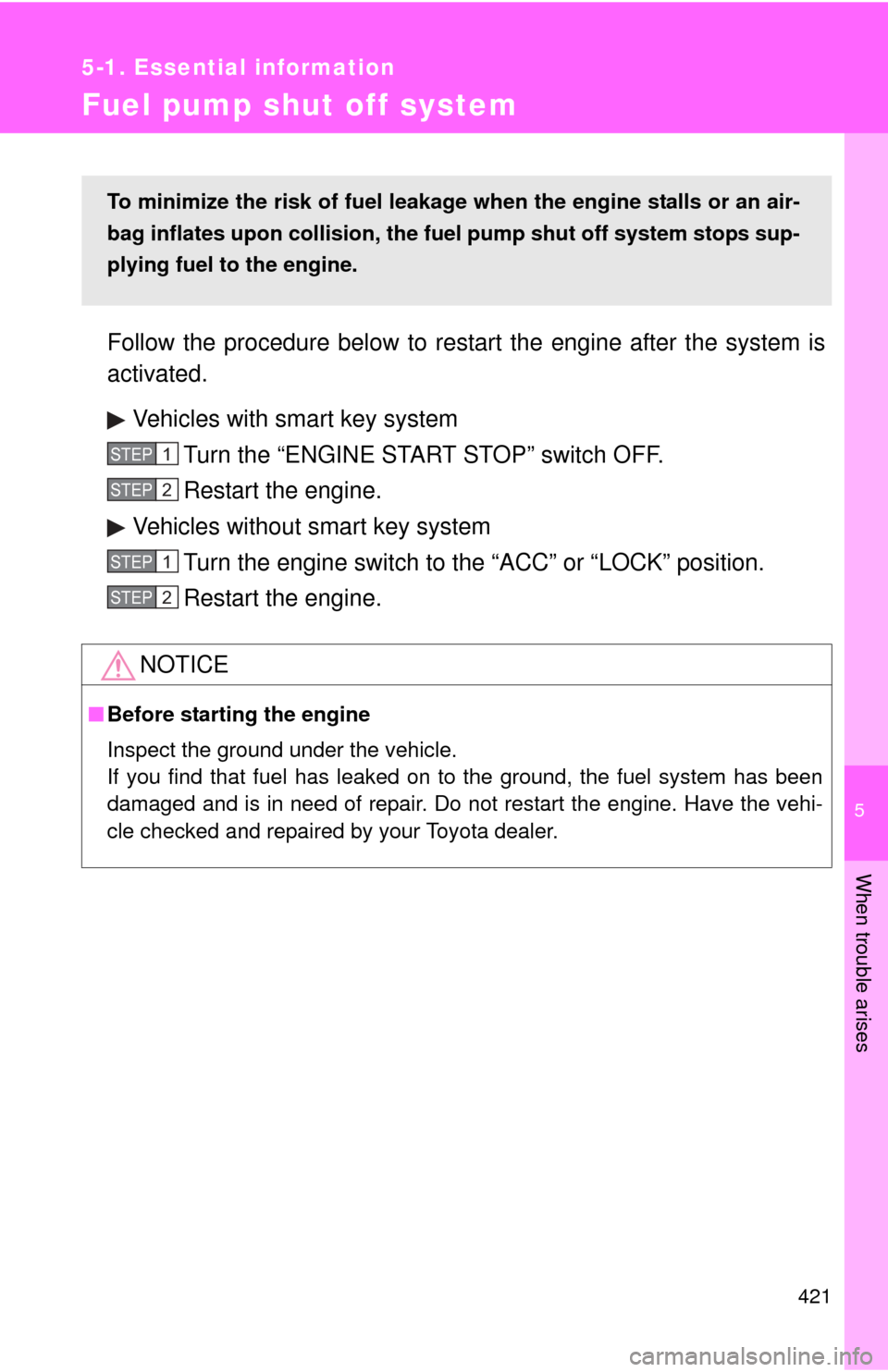
5
When trouble arises
421
5-1. Essential information
Fuel pump shut off system
Follow the procedure below to restart the engine after the system is
activated.
Vehicles with smart key system Turn the “ENGINE START STOP” switch OFF.
Restart the engine.
Vehicles without smart key system Turn the engine switch to the “ACC” or “LOCK” position.
Restart the engine.
NOTICE
â– Before starting the engine
Inspect the ground under the vehicle.
If you find that fuel has leaked on to the ground, the fuel system has been
damaged and is in need of repair. Do not restart the engine. Have the vehi-
cle checked and repaired by your Toyota dealer.
To minimize the risk of fuel leakage when the engine stalls or an air-
bag inflates upon collision, the fu el pump shut off system stops sup-
plying fuel to the engine.
STEP 1
STEP 2
STEP 1
STEP 2
Page 432 of 529
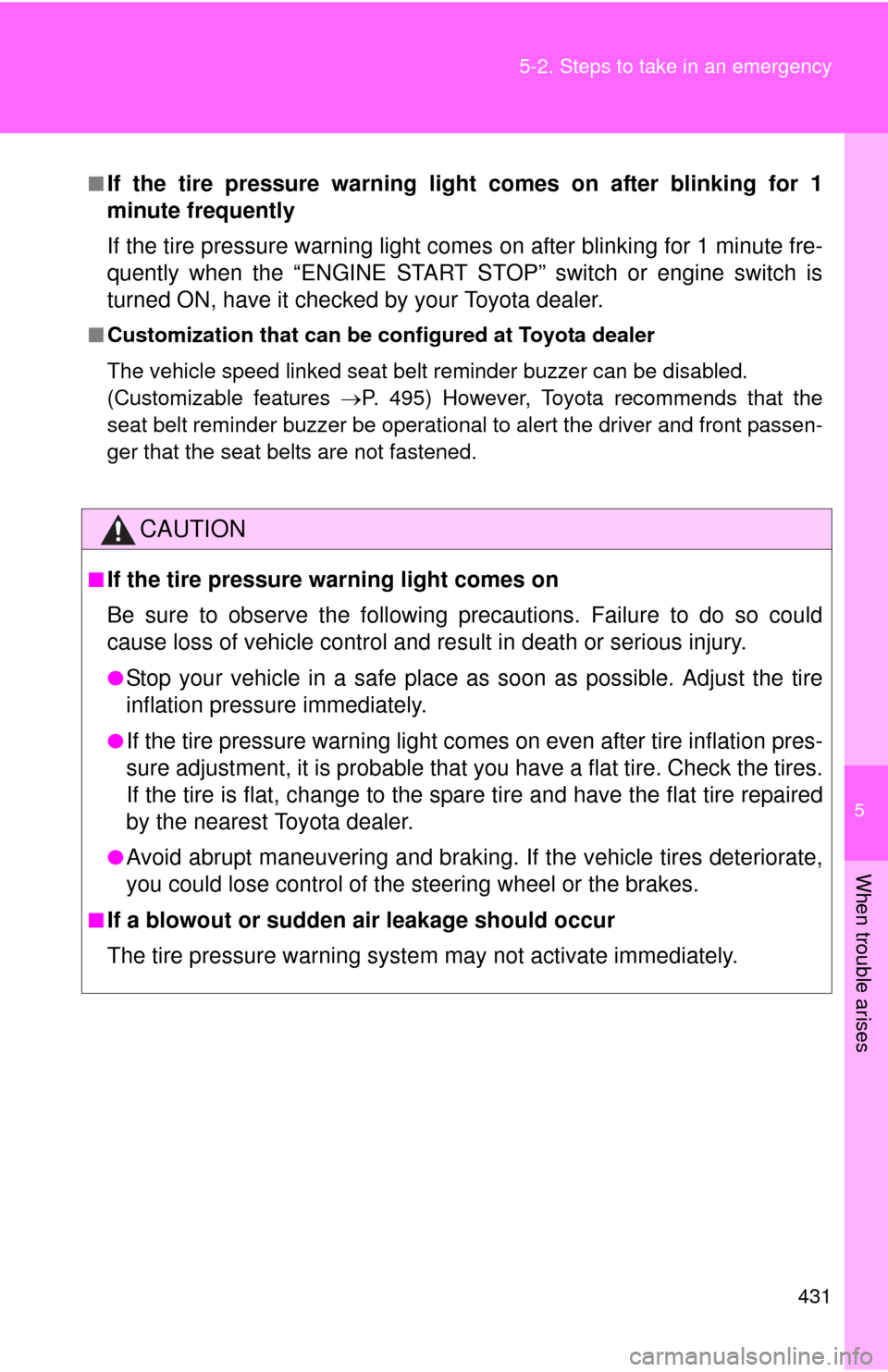
5
When trouble arises
431
5-2. Steps to take in an emergency
â– If the tire pressure warning light comes on after blinking for 1
minute frequently
If the tire pressure warning light comes on after blinking for 1 minute fre-
quently when the “ENGINE START STOP” switch or engine switch is
turned ON, have it checked by your Toyota dealer.
â–
Customization that can be co nfigured at Toyota dealer
The vehicle speed linked seat belt reminder buzzer can be disabled.
(Customizable features ď‚®P. 495) However, Toyota recommends that the
seat belt reminder buzzer be operational to alert the driver and front passen-
ger that the seat belts are not fastened.
CAUTION
â– If the tire pressure warning light comes on
Be sure to observe the following precautions. Failure to do so could
cause loss of vehicle control and result in death or serious injury.
â—ŹStop your vehicle in a safe place as soon as possible. Adjust the tire
inflation pressure immediately.
â—ŹIf the tire pressure warning light comes on even after tire inflation pres-
sure adjustment, it is pr obable that you have a flat tire. Check the tires.
If the tire is flat, change to the spare tire and have the flat tire repaired
by the nearest Toyota dealer.
â—ŹAvoid abrupt maneuvering and braking. If the vehicle tires deteriorate,
you could lose control of the steering wheel or the brakes.
â– If a blowout or sudden air leakage should occur
The tire pressure warning syste m may not activate immediately.
Page 435 of 529
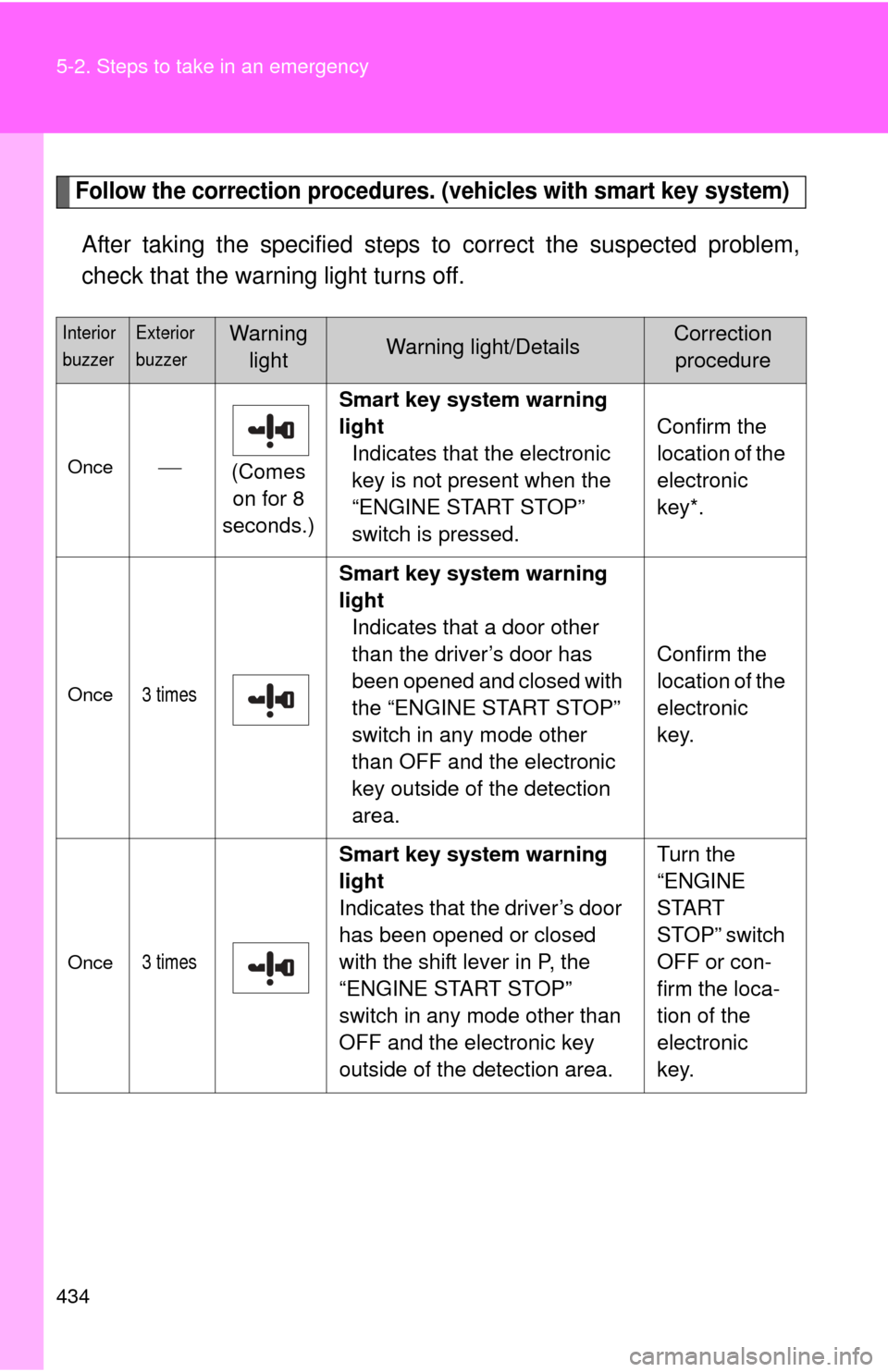
434 5-2. Steps to take in an emergency
Follow the correction procedures. (vehicles with smart key system)
After taking the specified steps to correct the suspected problem,
check that the warning light turns off.
Interior
buzzerExterior
buzzerWarning lightWarning light/DetailsCorrection procedure
Onceď‚ľ (Comes
on for 8
seconds.) Smart key system warning
light
Indicates that the electronic
key is not present when the
“ENGINE START STOP”
switch is pressed. Confirm the
location of the
electronic
key*.
Once3 times
Smart key system warning
light
Indicates that a door other
than the driver’s door has
been opened and closed with
the “ENGINE START STOP”
switch in any mode other
than OFF and the electronic
key outside of the detection
area. Confirm the
location of the
electronic
key.
Once3 times
Smart key system warning
light
Indicates that the driver’s door
has been opened or closed
with the shift lever in P, the
“ENGINE START STOP”
switch in any mode other than
OFF and the electronic key
outside of the detection area. Turn the
“ENGINE
START
STOP” switch
OFF or con-
firm the loca-
tion of the
electronic
key.
Page 445 of 529
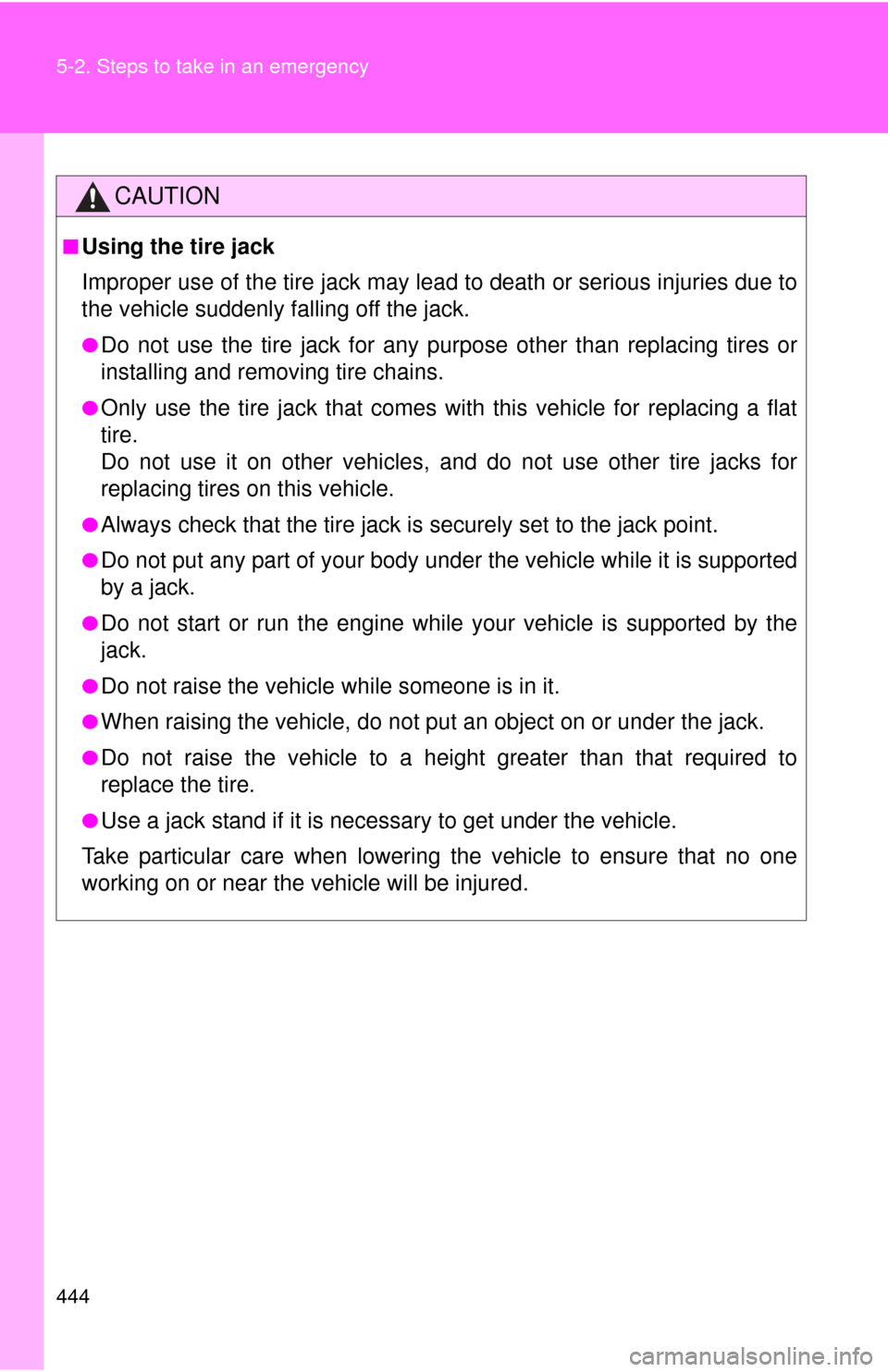
444 5-2. Steps to take in an emergency
CAUTION
â– Using the tire jack
Improper use of the tire jack may lead to death or serious injuries due to
the vehicle suddenly falling off the jack.
â—ŹDo not use the tire jack for any purpose other than replacing tires or
installing and removing tire chains.
â—ŹOnly use the tire jack that comes with this vehicle for replacing a flat
tire.
Do not use it on other vehicles, and do not use other tire jacks for
replacing tires on this vehicle.
â—ŹAlways check that the tire jack is securely set to the jack point.
â—ŹDo not put any part of your body under the vehicle while it is supported
by a jack.
â—ŹDo not start or run the engine while your vehicle is supported by the
jack.
â—ŹDo not raise the vehicle while someone is in it.
â—ŹWhen raising the vehicle, do not put an object on or under the jack.
â—ŹDo not raise the vehicle to a hei ght greater than that required to
replace the tire.
â—ŹUse a jack stand if it is necessary to get under the vehicle.
Take particular care when lowering the vehicle to ensure that no one
working on or near the vehicle will be injured.
Page 450 of 529
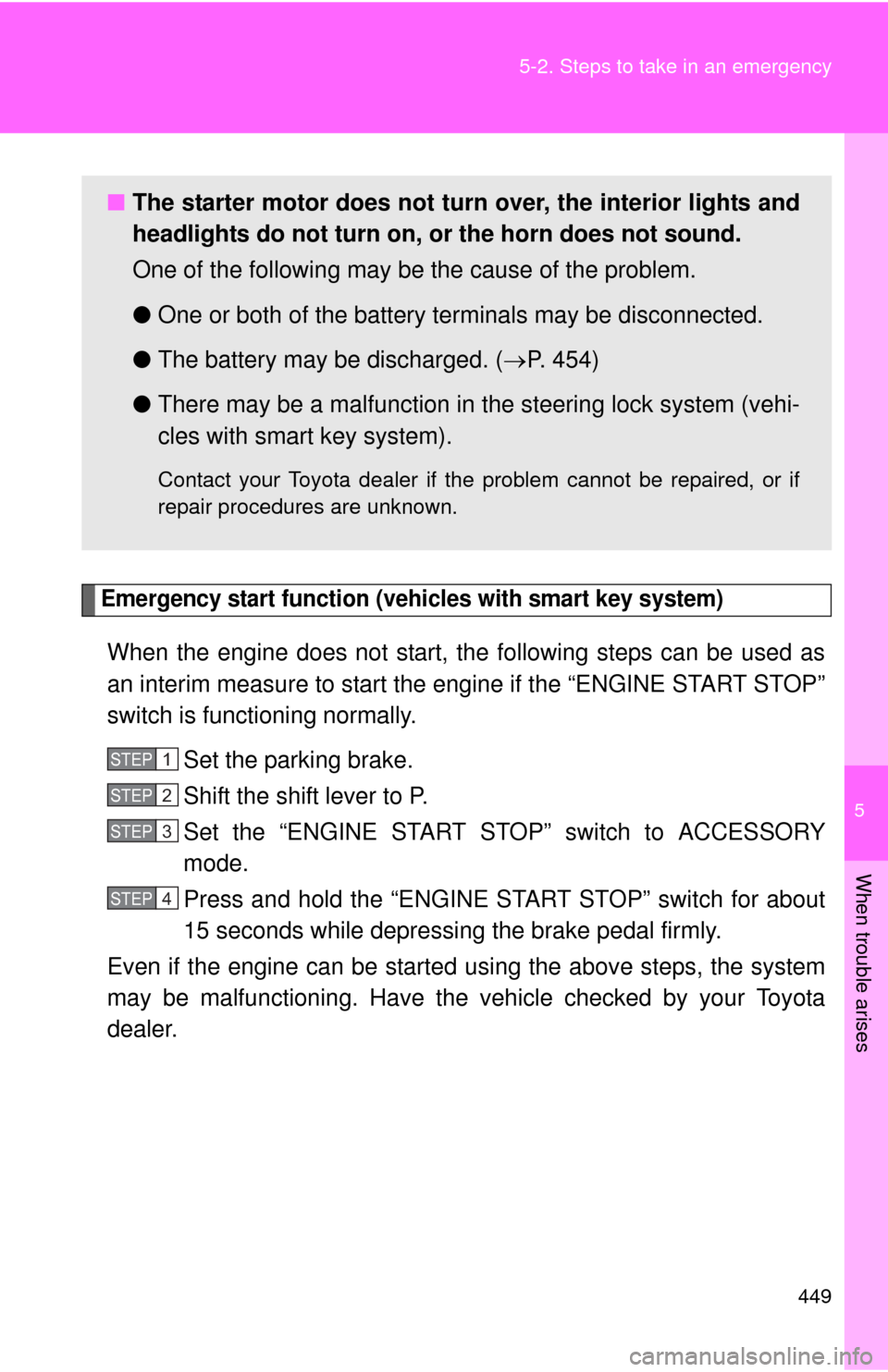
5
When trouble arises
449
5-2. Steps to take in an emergency
Emergency start function (vehicles with smart key system)
When the engine does not start, the following steps can be used as
an interim measure to start the engine if the “ENGINE START STOP”
switch is functioning normally.
Set the parking brake.
Shift the shift lever to P.
Set the “ENGINE START ST OP” switch to ACCESSORY
mode.
Press and hold the “ENGINE START STOP” switch for about
15 seconds while depressing the brake pedal firmly.
Even if the engine can be start ed using the above steps, the system
may be malfunctioning. Have the vehicle checked by your Toyota
dealer.
â– The starter motor does not turn over, the interior lights and
headlights do not turn on, or the horn does not sound.
One of the following may be the cause of the problem.
â—Ź One or both of the battery terminals may be disconnected.
â—Ź The battery may be discharged. ( ď‚®P. 454)
â—Ź There may be a malfunction in the steering lock system (vehi-
cles with smart key system).
Contact your Toyota dealer if the problem cannot be repaired, or if
repair procedures are unknown.
STEP 1
STEP 2
STEP 3
STEP 4
Page 457 of 529

456 5-2. Steps to take in an emergency
Once the vehicle’s engine has started, remove the jumper
cables in the exact reverse order in which they were con-
nected.
Once the engine starts, have the vehicle checked at your Toyota
dealer as soon as possible.
2.4 L 4-cylinder (2AZ-FE) engine
Connecting the jumper cables Positive (+) battery terminal on your vehicle
Positive (+) battery terminal on the second vehicle
Negative (-) battery terminal on the second vehicle
Connect the jumper cable to ground on your vehicle as shown in
the illustration. Start the engine of the second vehicle. Increase the engine
speed slightly and maintain at that level for approximately 5
minutes to recharge the battery of your vehicle.STEP 6
STEP 1
STEP 2
Page 458 of 529

5
When trouble arises
457
5-2. Steps to take in an emergency
â–
Avoiding a discharged battery
â—ŹTurn off the headlights and the audio system while the engine is turned
off.
â—Ź Turn off any unnecessary electrical components when the vehicle is run-
ning at a low speed for an extended period, such as in heavy traffic, etc.
Maintain the engine speed of the second vehicle, and turn
the engine switch to the “ON” position, then start the vehi-
cle's engine.
Once the vehicle’s engine has started, remove the jumper
cables in the exact reverse order in which they were con-
nected.
Once the engine starts, have the vehicle checked at your Toyota
dealer as soon as possible.STEP 3
STEP 4
Page 461 of 529
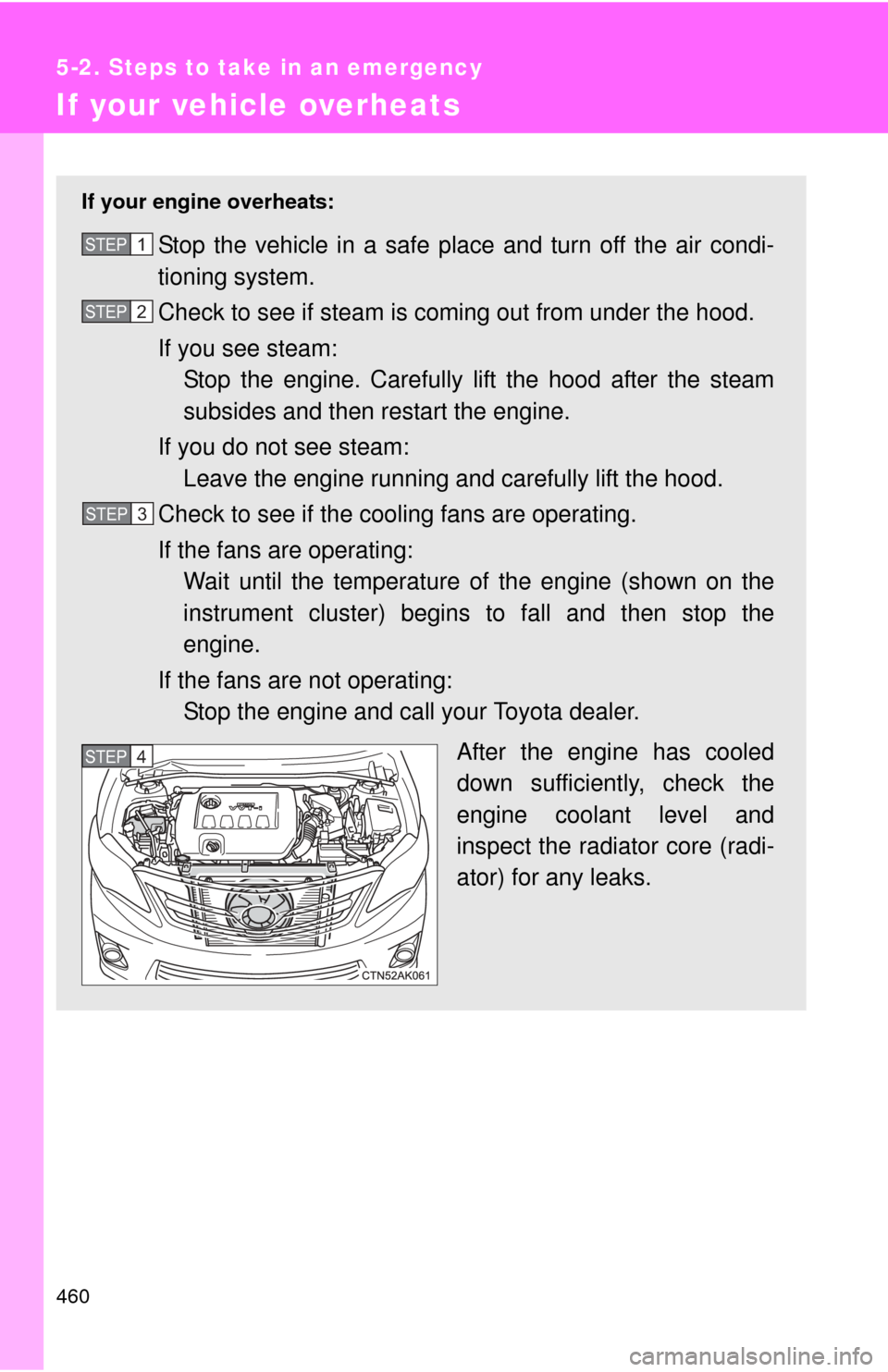
460
5-2. Steps to take in an emergency
If your vehicle overheats
If your engine overheats:
Stop the vehicle in a safe place and turn off the air condi-
tioning system.
Check to see if steam is coming out from under the hood.
If you see steam: Stop the engine. Carefully lift the hood after the steam
subsides and then restart the engine.
If you do not see steam: Leave the engine running and carefully lift the hood.
Check to see if the cooling fans are operating.
If the fans are operating: Wait until the temperature of the engine (shown on the
instrument cluster) begins to fall and then stop the
engine.
If the fans are not operating: Stop the engine and call your Toyota dealer.
After the engine has cooled
down sufficiently, check the
engine coolant level and
inspect the radiator core (radi-
ator) for any leaks.STEP 1
STEP 2
STEP 3
STEP 5 STEP 4
Page 477 of 529

476 6-1. Specifications
Electrical system
Manual transaxle
Battery
Open voltage at
68ď‚°F (20 ď‚°C): 12.6 ď‚ľ 12.8 V Fully charged
12.2 ď‚ľ 12.4 V Half charged
11 . 8
ď‚ľ 12.0 V Discharged
(Voltage checked 20 minutes after the
engine and all the lights turned off)
Charging rates 5 A max.
Gear oil capacity (Reference) 1.8 L 4-cylinder (2ZR-FE) engine
2.0 qt. (1.9 L, 1.7 Imp. qt.) 2.4 L 4-cylinder (2AZ-FE) engine
2.6 qt. (2.5 L, 2.2 Imp. qt.)
Gear oil type TOYOTA Genuine Manual Transmission
Gear Oil LV or equivalent
Recommended API grade GL-4
Recommended gear oil
viscositySAE 75W
NOTICE
â–
Manual transaxle gear oil
Using manual transaxle gear oil other than “TOYOTA Genuine Manual
Transmission Gear Oil LV” may cause occurrence of idle rattling noise and
bad fuel consumption.
Page 520 of 529

519
Alphabetical index
Electric power steering........... 166
Electronic key
If your electronic key battery is discharged .......... 452
Emergency flashers
Switch ................................... 414
Emergency, in case of If a warning light turns on ..... 424
If the electronic key does
not operate properly ........... 452
If the engine will not start...... 448
If the shift lever cannot be
shifted from P ..................... 450
If the vehicle has a
discharged battery ............. 454
If the warning buzzer sounds ............................... 424
If you have a flat tire ............ 436
If you lose your keys............. 451
If you think something is wrong ................................. 420
If your vehicle becomes stuck................................... 463
If your vehicle has to be stopped in an emergency... 465
If your vehicle needs to be
towed ................................. 415
If your vehicle overheats ...... 460
Engine
Compartment........................ 356
Engine switch ............... 129, 133
Hood ..................................... 351
How to start the engine ........................ 129, 133
Identification number ............ 468
If the engine will not start...... 448
Ignition switch ............... 129, 133
Overheating .......................... 460
Engine coolant Capacity ............................... 475
Checking .............................. 362
Preparing and checking before winter ...................... 174 Engine coolan
t temperature
gauge ......................................147
Engine immobilizer system.......79
Engine oil Capacity ................................473
Checking ...............................358
Preparing and checking before winter .......................174
Engine oil maintenance data .........................................360
Engine switch light ..................309
EPS ............................................166
Event data recorder .................422
Floor mat...................................329
Fluid
Brake .....................................363
Washer ..................................368
Fog lights
Replacing light bulbs .............400
Switch....................................159
Wattage .................................479
Front passenger occupant classification system ..............97
Front passenger's seat belt
reminder light.........................426
Front seats Adjustment ..............................49
Front side marker lights Replacing light bulbs .............400
Switch....................................157
Wattage .................................479
Front turn signal lights Replacing light bulbs .............400
Switch....................................144
Wattage .................................479E
F